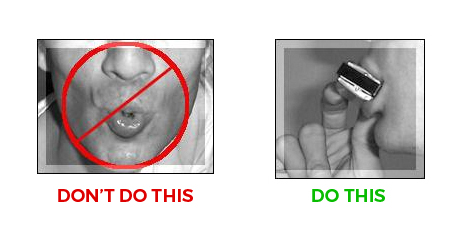You will see people on forums very dogmatically declaring that tongue blocking is the only correct way to play the harmonica. Then you will have someone send a video of them playing in the pucker style sounding like a pro! The tongue blocker will then explain how much BETTER he would sound if only he would change embouchures.
For those new to the harmonica world, the deep relaxed mouth position that JP teaches is a version of the pucker style embouchure, but he sometimes refers to it as a “half pucker” as it emphasizes:
- The relaxation of the upper lip
- The slight puckering of the lower lip
- The increased angle of the harmonica down into the lower lip
See figure below for more clarity or CLICK HERE.

JP recommends his half pucker technique to (1) beginners who are learning how to bend and (2) those who don’t feel confident playing single notes. But once a student feels confident with single notes and bending, JP is also an advocate of the extremely popular tongue blocking embouchure.
What you won’t hear, is someone talking about U blocking. Poor forgotten U blocking; it’s sitting in the corner all alone. If only people knew how great its advantages were, then someone would play with it!
It is my opinion that all three embouchures have advantages, things one does better than the other two. You can intellectually understand these advantages, but only after mastering all three methods will one truly feel and hear the advantages. Then, if you have a musical phrase in mind, you will be able to shift to the embouchure best suited to knock it out of the park.
Remember when you first began puckering? You are probably much better now. The start of tongue blocking is often dismal and it can take years to develop a professional embouchure, but boy is it ever worth it. I suggest U blocking is like this. The advantages will reveal themselves, sometimes after months or even years of practice.
Genetics

The impression people have of what the tongue needs to do in order to U block
Can you curl your tongue like a U?
It is a genetic trait. If you cannot, all of the practice in the world will not get you to be able to.
Actually, that is not true. I know a player who wanted the U block so badly he wrapped a rubber band tightly around his tongue. He held on until the pain became too great and then pulled the band off. He waited for the pain to subside and replaced the band. Hours a day and one year later, he can curl his tongue in a U. True story.
If you cannot curl your tongue, most harp teachers will say, “Well, that’s that. U blocking is not in the cards for you. Onto the next thing!”
To Curl or Not to Curl
I am at the forefront of a small group of teachers who say the curl is superfluous. The active ingredient in making U blocking work is something else and EVERYONE can do the something else.
I have not told this to the rubber band guy. I wouldn’t dare.
I first started thinking there was a misconception when I was teaching at a harmonica seminar. Another teacher was a famous U blocker. He had a tool I HAVE to get. It was a clear harmonica. He had taken out the insides so you could see what his tongue was doing.
He explained the curl. He showed the curl without the harmonica. He placed the harp in his mouth. He began to play.
Immediately the curl disappeared!
I then started experimenting with curling my tongue in a mirror. What I noticed was that, to create a curl, my tongue needed to be sitting on my bottom lip. When I pulled the tongue into my mouth past my lower lip, the curl disappeared!

The “without” method which I found more effective
I began practicing with the most intentional curl I could make and without. The without method felt more like what I was doing when I played naturally. I began teaching people who could not curl to do the “without” method. After some practice, they had great tone and all of the advantages I get from U blocking.
Therefore, I claim the curl of the tongue to be superfluous.
Now, is the tone different whether or not you curl the tongue? Probably. Every little thing you do makes a difference in tone. Is it important or negligible? I suppose that’s personal choice. I am choosing negligible.
How It’s Done
Place the harp in your mouth as though puckering. Everything you do to get a good pucker can remain.
Now place the tip of your tongue centered underneath the intended hole on the bottom cover plate. Try hole 4 blow. If you want, curl the tongue in a U shape and block out holes 3 and 5 with the sides of your tongue. It isn’t necessary, but cannot hurt.
Essentially you are puckering with the added centering of your air via your tongue.

To move left and right, one method is you push and pull the harp with your hands. When you do this, you need to keep your tongue with enough pressure on the harp that it remains centered. HOWEVER, the pressure has to be light enough that the harp can glide over the tongue.
Moving the jaw and tongue right and left to achieve adjacent holes without moving the head or hands.
Why the Heck Would I Ever Do This?
There are four main advantages to U Blocking: mid-range slaps and lifts, chromatic single notes, jaw movement and the high end of the diatonic.
Mid-Range Slaps and Lifts
Width is my term for the opening of your mouth from cheek to cheek. When you smile, you have a big width. Standard tongue blocking uses a four-hole width. Generally, you block three holes to the left of the intended hole and play the intended hole out of the right-hand side of your mouth. If you continue to blow or draw air and pull your tongue away, you get a rapid shift from a single note to a chord.
This technique is sometimes called a tongue pull and sometimes called a tongue lift. I think it is a generational thing. Older generations seem to use pull more often, newer seem to use lift.
There is another meaning of the word tongue pull where you tongue block all the holes so no sound is made. Then you suck or blow and still no sound is made. Then you pull away your tongue and get a chord. But you also get a bit of a popping sound from the pulling away of the chord, like opening a soda can.
Since there are two meanings to the same term, I reluctantly surrender to the term lift. But GET OFF MY LAWN!
If you begin with a chord, continue to breathe and rapidly place your tongue on the three lower holes, creating a single note. This is called a tongue slap.
Because the chord includes notes LOWER than the intended single note, it produces a bass sound.
It is possible to tongue block where the intended hole is to the left of the tongue. When the tongue is released, the chord produced is HIGHER than the intended single note. This produces a treble chord.
When U blocking, the chord produced when lifting or before a slap surrounds the intended single note. For example, the chord for the intended 4 blow is holes 3,4 and 5.
Chromatic Goodness
When I play chromatic, if I want a clean single note, I am almost always U blocking. I love the tone. “Facility” means how easy it is to move around the harp. “Responsiveness” means how well and quickly the harp does what you ask it to do. To me, U blocking single notes on a chromatic gets the best facility and responsiveness, especially when it comes to bending. Many people have the misconception that there is no bending on the chromatic since bending on the diatonic produces notes not built onto the instrument. Since all keyboard notes are built onto the chromatic, what is the purpose of bending? It is for inflection and feeling. Unlike the diatonic, every blow and draw note can bend on a chromatic, and U blocking has proven to me to be the easiest way to do it.
Jaw Movement
Jaw movement is another method of playing adjacent holes. Most professionals agree to move the hands, not the head. There is nothing wrong with moving the head or a combination of head and hands. But the jaw provides another way.
Jaw movement can occur while puckering and U blocking. As far as I can tell, it cannot work during tongue blocking.
Although advanced jaw movement with a wide range of five holes can be learned in the pucker style, it is much easier to get a five-hole range in the U block style.
To learn jaw movement, I recommend starting with puckering. Play 4 blow. Continue to blow the same steady stream of air and move your jaw left and play 3 blow. Move your jaw right. Play 4 blow again, then 5 blow. Move left, back to center.
This is a three-hole range. Hole 4 is the center hole and the pivot point.
Now place your tongue in the U Block position, underneath 4 blow on the bottom cover plate. As you move your jaw left and right, move your tongue in combination with the jaw.
Since you are not moving your head or your hands, this can lead to some very fast playing.
A great song to practice jaw movement is Oh Suzannah because it takes place entirely in holes 4, 5 and 6, centered on 5.
However, the song does not begin on 5 blow, it starts on 4 blow. I recommend centering yourself on 5 blow and playing it to insure your center is correct, playing an E note on a C harp into a tuner. Then pause, move your jaw to the left and begin the song.
Next, practice a song with a greater range such as Happy Birthday. When you pick a song with a six-hole range or greater, move your jaw as far right or left as a five-hole range will allow, keep your jaw to the side and push the harp with your hands, altering the center of the song.
Master the High Notes
Finally, to understand the fourth, and in my opinion, most valuable advantage of U blocking, we have to step away from U blocking and talk about the harmonica in general.
To learn harmonica, it is CRUCIAL that you understand this next idea. Luckily, it is easy to understand.
Blow then draw in to hole 1. Listen. Can you hear how it moves from a low note to a higher note?
Now blow and draw into hole 10. Can you hear how it is the opposite? It moves from a high note to a low note.
This shift from blow draw low high to blow draw high low occurs between holes 6 and 7.
A great way to feel it is the do re mi fa so la ti do.
Play 4 blow, 4 draw, 5 blow, 5 draw, 6 blow, 6 draw, 7 draw, 7 blow.
This scale ascends further and further with each successive note. Therefore you can feel and hear the breath direction shifting on hole 7.
Therefore, most harmonica players refer to holes 1 through 6 as the low end of the harp and holes 7 through 10 as the high end of the harp.
Because most harmonicas players are self-taught, when they play the high notes they get confused. Some cannot put into words what the difference is. Some can, but the difference proves too great and is not intuitive. They get scared. They run away and they never learn how to play the high notes.
It is not unusual to see many harmonica players play for hours at a harmonica festival and never hear a note higher than hole 6.
There are technical difficulties to playing the high notes. People complain that they are breathy, thin in tone and difficult to bend and overblow. With a year’s worth of practice those problems tend to go away and never return.
Therefore, the real difficulty in learning the high notes is having COURAGE! Don’t be afraid of them. Spend time with them and they will fall into place.
The third advantage of U blocking is it solves the technical problems of the high notes. Although I have learned to pucker and tongue block the high notes at a professional level, the tone, facility and responsiveness of U blocking is so superior I rarely ever use the other embouchures.
I believe in this so much I often have this conversation with my students:
“Let’s learn to bend the high notes. Try U blocking.”
“No, I’m a pucker player.”
“You should try U blocking. Give it three months.”
Three months later:
“How’s your high notes?”
“Terrible!”
“Have you tried U blocking?”
“No, I’m a pucker player!”
“You should try U blocking!”
A year later, we repeat the conversation.
I have other students. Three months later:
“How’s your high notes?”
“Great!” Then they play an amazing lick,
“Wow! What are you doing right?”
“I’m U blocking like you said. It was difficult for three days and then it kicked in.”
I have these conversations all the time.
On the other hand, although I am very dogmatic about what kind of music I like, I am pretty relaxed about the physical ways to make good sounds on the harmonica. If it sounds good, it is good.
If you wanted to, you could practice hard and learn to play the high notes well in the pucker or tongue block style.
If you practice hard enough, you can play the harmonica through your nose.
To me those four advantages of U blocking, mid-range slaps and lifts, nice chromatic single notes, wide range of jaw movement and control of the high notes are more than enough to get me to be serious about U blocking.
As to famous U blockers, there are rumors that both Little Walter and Butterfield U blocked. The Little Walter bio, Blues with a Feeling, quotes harp player Joe Lee Bush as stating Walter taught him that method. Recently, a video featuring Levon Helm, the drummer, mandolinist and vocalist for The Band, stated Butter taught him U blocking.
This does not mean this was their only embouchure. Both players are recorded playing sounds that could only be made using tongue blocking. But it means they were aware of U blocking and developed it to a proficient level.
Norton Buffalo claimed many times that he was 100% U blocker except for chords and octaves. He is proof that one can play single notes and bends cleanly, fluidly and fast using U blocking. He also had a unique tone, which I suggest had to do with U blocking.
Let’s bring in the redheaded stepchild as a full member of the family!

Comments
Got something to say? Post a comment below.